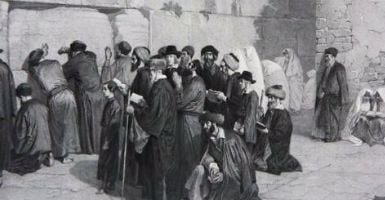There is a fundamental Machlokes Rishonim concerning Chillul Shabbos for a Choleh sheYesh Bo Sakana. According to one view, it is ideal to perform any necessary actions with either a Shinui or through a non-Jew if this will not cause a delay in treatment. According to the other view, it should be performed by a Jew. The Shulchan Aruch and Rema take opposing sides of this Machlokes (O.C. 328:12):
When desecrating Shabbos for a Choleh sheYesh Bo Sakana, one should endeavor to do so not through non-Jews, minors, or women, but by Jewish adults of sound mind.
Rema: Some say that if it is possible to do it without delay with a Shinui, one should perform it with a Shinui. And if it is possible by a non-Jew without any delay, he should [have] a non-Jew do it. This is the Minhag. But in a case where one is concerned that the non-Jew will dally, one should not do it through a non-Jew (Tosfos and Ran).
By contrast, when discussing a Yoledes, all agree that a Shinui should be employed whenever possible. This is evident from the Shulchan Aruch (O.C. 330:1):
A Yoledes is like a Choleh sheYesh Bo Sakana and Shabbos should be desecrated for all her needs. One may summon an expert midwife from one place to another, deliver her baby for her, [or] light a candle for her, even if she is blind. Nevertheless, whatever can be performed with a Shinui should be. For example, if one needs to bring a vessel for her, her friend should bring it tied in her hair.
The Magid Mishna (Hilchos Shabbos 2:11) explains:
From [the Rambam]’s expression, it appears that a Choleh sheYesh Bo Sakana does not require a Shinui – only a Yoledes…. and he writes above, “The rule is: Shabbos regarding a Choleh sheYesh Bo Sakana is like a weekday in all matters, etc.” The reason appears to be that the pain and labor pains of a Yoledes are natural for her – not even one in a thousand dies in childbirth. Therefore, they were stringent in requiring a Shinui where possible, but they were not stringent with a Choleh.
The Mishna Berura comments on the Shulchan Aruch’s instruction that a friend of the Yoledes should bring her a vessel “tied in her hair”:
Tied in her hair – not in the manner of those who carry things outside – which is only a Shevus. This is better than applying the oil to her hair, bringing it to her, and squeezing the hair. For that would entail another Issur of Sechita. Even though Sechita does not apply to hair (to be liable) nevertheless, it is certainly Asur as a Shevus.
The Mishna Berura’s source is the Beis Yosef:
…although Sechita does not apply to hair, there remains an Issur [d’Rabbanan], as the Magid Mishna states (9). If so, it is preferable to carry with a Shinui which involves no other Issur rather than to add an Issur Sechita.
The Avnei Nezer has a great Chiddush on this matter. To understand it we must briefly examine a passage of Gemara in Maseches Menachos (64a):
Rava raises a question of a Choleh who is instructed on Shabbos to eat two figs and can either pick two individual figs or three figs together from one cluster, thus leading to picking an extra fig. (The Gemara concludes, “Obviously, he takes three, for R’ Yishmael only stated [his view][1] in that case where by reducing the [quality of[2]] the food he also reduces the harvesting. But in this case, by reducing the food, he increases the harvesting, thus he should certainly take the three.”)
It would seem that the entire discussion in the Gemara is based on the fact that the second option results in picking an extra (and unnecessary) fig. What would the Halacha be if there were only two figs on one branch? May the Choleh take from whichever he wants or is he required to take from one branch since fewer Melachos are performed that way?
As an aside, the Rishonim disagree regarding the Issur of unnecessarily increasing the amount of Melacha (Ribui b’Shiurim). The Rashba (Beitza 17a) asserts that it is only an Issur d’Rabbanan whereas the Ran holds it is mid’Oraisa. The Ran supports his view from this Gemara; if indeed the Issur was mid’Rabbanan, it would surely be obvious that the Choleh must pluck the three figs else he would be increasing the amount of Melacha d’Oraisa (picking figs) to prevent a d’Rabbanan (Ribui b’Shiurim).
The Ran explains that in cases of Pikuach Nefesh the Halachos of Shabbos are Dechuya (set aside, rather than completely waived). Hence, anything that is not strictly necessary for saving a life constitutes Chillul Shabbos mid’Oraisa.
Strangely, the Rashba himself also holds that Pikuach Nefesh is Dechuya, as he states explicitly in a Teshuva (1:689):
I heard from one of the great Rabbis who testified in the name of haRav Meir m’Rothenburg that he ruled to permit slaughtering even where [the Choleh] could be fed with Neveila… It seems to me that it all depends on the Machlokes if Shabbos is Dechuya or Hutra (completely waived) for a Choleh… Halacha appears to follow the view of the one who says that Shabbos is Dechuya, not Hutra.
Clearly, according to the Rashba, the Issur of Ribui Shiurim is not dependent on whether Shabbos is Hutra or Dechuya; though Shabbos is Dechuya, the Issur remains a d’Rabbanan. The Ran, by contrast,understands the two to be linked.
HaGaon Rav Asher Weiss Shlit”a (Minchas Asher, Shabbos 80) explains why the Rashba does not consider the two Halachos to be connected. In his view, a Melacha is considered one action regardless of the Shiur. Since the act of plucking was permitted for this Choleh,there is no Issur d’Oraisa in obtaining the third fig simultaneously even if Pikuach Nefesh is merely Dechuya.
Let us return to our discussion. The Shulchan Aruch rules (328:16):
If they determined [that the Choleh] needs two figs but they only found two figs on two branches and three on another, they cut the branch that has three. But if there were two on one branch and three on the other, they may only cut the branch that has two.
If there are two figs on one branch or two on separate branches, we should presumably limit the number of Issurim and cut the branch that has two. However, this is not the conclusion of the Avnei Nezer (O.C. 157):
That which is stated in Menachos (64a) regarding a Choleh who was determined [to need] two figs and there are two on one branch and three on one branch, that we cut the branch with two, not with three – this is because the third fig is not necessary for the Choleh. This is why the Poskim do not state that it is forbidden to cut two branches if there are two figs on a single branch because it is actually permissible. For it is all necessary, even though he increases the Ketzira. Look closely at the Shulchan Aruch (328:16) and you will see that this is so.
In other words, when a person must transgress an Issur for Pikuach Nefesh, he need not be concerned to lessen the number of Issurim. For example, if a Choleh requires two figs and he can either cut one branch of two figs, or two branches each with one fig, since he requires all the figs he need not specifically choose the first option. The Avnei Nezer states likewise regarding a Yoledes:
… I have a further question: The Rambam (Hilchos Shabbos 2:11) rules: “When a woman crouches to give birth… and we desecrate Shabbos for her… if she needs oil we bring it for her. Whatever can be done differently at the time of bringing should be done; for example, her friend should bring her a vessel tied in her hair.” The Kesef Mishna explains: “Rabbenu wrote here that she should bring her a vessel tied in her hair (but not [oil] in her actual hair) since, although Sechita does not apply to hair, there is still an Issur [d’Rabbanan], as the Magid Mishna states (9). If so, it is preferable to carry with a Shinui with no other Issur rather than to add another Issur.”
I find this difficult because [the Gemara] Pesachim (79a) states: “The Rabbis taught: If the Yisraelim were Tamei and the Kohanim and Klei Shares were Tahor, or the Yisraelim were Tahor and the Kohanim and Klei Shares were Tamei, or even if the Yisraelim and Kohanim were Tahor and the Klei Shares were Tamei – they may perform [the Pesach offering] in [a state of] Tumah. Rav Chisda said: This applies when the knife contracted Tumas Meis, since the Torah states, “a corpse [killed] by the sword” – a sword is like a corpse and imparts Tumah to a person. Thus, when [the Pesach] is initially performed it is done in a state of Tumas haGuf [that usually incurs] Kares. But if the knife contracted Tumah from a Sheretz which only contaminates meat but not a person, [those who are Tamei should not perform it as] it is better that he eats Tumah of meat which is a Lav, rather than eating in a state of Tumas haGuf which [usually] incurs Kares. Thus, we see Rav Chisda holds that Tumah is Dechuya in a congregation [since he differentiates between the cases].
We see that even though it is Dechuya, if the Kohanim are Tamei the owners may eat in Tumas haGuf [that usually incurs] Kares since the Avoda was performed in Tumas haGuf [that usually incurs] Kares. We do not say that we should not add another Issur. Thus, since they are forced to transgress one Issur they may transgress more Issurim like it, as long as it is necessary for the Korban. Likewise regarding the Yoledes; although Shabbos is Dechuya for her, since they must carry with a Shinui which is Asur mid’Rabbanan we are not concerned with adding another Issur of Sechita of hair which is d’Rabbanan.
Rav Asher (Minchas Asher, Shemos 50) records a Machlokes between two of the Avnei Nezer’s Talmidim who discuss this Chiddush:
HaGaon Rav Meir Dan Plotzky[3] (Chemdas Yisrael, Kuntres Derech Chaim 17) rejects the Avnei Nezer’s approach since the Gemara states that one would even need to pick three figs on one branch rather than two on two separate branches. However, the Eretz haTzvi[4] (Shu”t 2:26) argues with the Chochmas Adam who refutes the Avnei Nezer and resolves the Avnei Nezer’s approach by an inference from the Shulchan Aruch (ibid.):
“If they determined [that the Choleh] needs two figs but they only found two figs on two branches and three on another, they cut the branch that has three. But if there were two on one branch and three on the other, they may only cut the branch that has two.”
In the first case of two [figs] on two branches and three on one branch he (the Shulchan Aruch) does not formulate it as an Issur, but states, “They cut the branch that has three”. Meaning, it is permissible to cut the branch of three. For I would have presumed it to be Asur since, although he lessens the harvesting, he nevertheless increases the Shiur. The Chiddush is that he may cut the branch of three, but he may also cut the two branches of one fig each. But when he has the option of two on one branch and three on the other, the Shulchan Aruch states, “They may only cut the branch that has two”. In this case, one may not cut the branch of three figs since the Choleh only requires two.
Rav Asher disagreed with this inference:
Great love ruins straight thinking.[5] This inference from the Shulchan Aruch’s wording is flimsy; not a wall upon which “one may build a silver fort”[6]. It seems more likely that the Shulchan Aruch meant “not only this but even that”. Certainly, a person may not cut two branches when he could cut only one since this would increase the cutting, but one may not even cut one branch of three when he can cut one of two since it is forbidden to increase the Shiur. This is explicit from the source: the Sugya in Menachos (64a):
“Rava asked: If they evaluated that a Choleh needs two figs and there are two figs on two branches and three on one branch, which should they take – should they take the two since they are what he needs or should they take the three since he reduces the harvesting? Obviously, he takes three, for R’ Yishmael only stated [his view] in that case where by reducing the [quality of] the food he also reduces the harvesting. But in this case, by reducing the food, he increases the harvesting, thus he should certainly take the three.”
We see that it is more logical to reduce the amount of harvesting than to reduce the Shiur and consumption. The Chiddush is that although both options only involve cutting one branch, the Choleh must nevertheless reduce the Shiur. Extreme love ruins straight thinking; the great Gaon, author of Eretz Tzvi, was so attached to his Rabbi in admiration that he toiled in his Rabbi’s words as one toils in the words of the Rishonim (indeed, the Avnei Nezer states in E.H. 122 that this is how his words should be studied). Yet in our case, he went too far and, in truth, the Avnei Nezer’s words are a Chiddush.
This discussion pertains to a regular Choleh. However, as mentioned above, a Yoledes is treated more stringently than a Choleh sheYesh Bo Sakana (in that one must employ a Shinui as much as is feasible). Thus, the Avnei Nezer’s objection about carrying oil in one’s hair would seem to have no place here. This objection is made by the Shevet haLevi (5:45):
If not for his words, this would be exceedingly strange. Certainly, one must take into account additional Melacha in general concerning Pikuach Nefesh and the like. But, regarding a Yoledes, the Hagahos Maimonis states that the reason we must employ a Shinui and reduce the Chillul for a Yoledes, as opposed to other Pikuach Nefesh cases, is because giving birth is a natural Sakana. This is cited by the Poskim (Siman 330). In truth, even for giving birth, if [the Shinui] is insufficient it becomes permitted like any Pikuach Nefesh.
In other words, the same reason that compels us to utilize Shinuim and minimize Chillul Shabbos for a Yoledes is what teaches us to limit the Issurim and prevent more Melachos.
[1] In the Mishna on Daf 63b, R’ Yishmael states that only 3 Se’ah of barley were harvested for the Korban Omer on Shabbos but if the 16th of Nissan was on a weekday, 5 Se’ah were harvested.
[2] [Editor’s note: See Rashi s.v. Ela Mishum who uses the term “Hana’as ha’Ochel”.]
[3] 1866-1928, member of the Moetzes Gedolei haTorah and president of Kollel Polen, author of Kli Chemda on Chumash and Chemdas Yisrael on Sefer haMitzvos.
[4] R’ Aryeh Tzvi Frumer (1884-1943) Hy”d, Kozighlover Rav, Rosh Yeshiva of the yeshiva in Sochaczew (Sochatchov) 1910-1914, and Rosh Yeshiva of Yeshiva Chachmei Lublin 1934-1939. He was murdered in the Majdanek concentration camp in the spring of 1943.
[5] Bereishis Rabba, Parshas Vayera 55:8.
[6] Shir haShirim 8:9.















Add comment